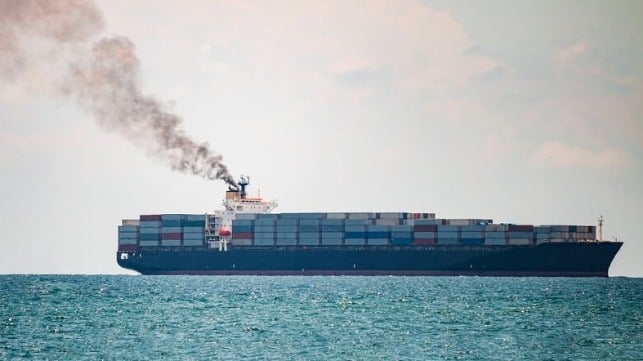NGO Calls for Slow Steaming Saying Emissions Per Container Is Same as 2018

The influential NGO T&E (European Federation for Transport and Environment) released new data reporting no real-world improvement in containership efficiency despite investments into new technology. It is increasing its call for ships to sail at slower speeds and use newer technologies such as wind-assisted propulsion.
The group seeks to disprove the contention of policymakers and the IMO that higher prices for fuel from emission pricing and fuel standards will lead to efficiency improvements and emissions reductions. T&E commissioned the well-known independent research firm CE Delft to study the relationship between fuel prices and technical and operations efficiency. They concluded that there is no clear relationship between higher fuel prices and better operational efficiency.
Analyzing the EU’s MRV data (monitoring, reporting & verification), they concluded despite price increases over the past six years in fuel, on a per container basis Europe’s container ships are producing the same level of emissions as they did six years ago in 2018. They acknowledge that the EU’s latest shipping data showed a small decline in emissions in 2023 compared to 2022, but they attribute that to a likely fall in trade.
“There just aren’t enough incentives for ships to sail more efficiently,” said Jacob Armstrong, shipping manager at T&E. “Shipping companies are reacting to higher fuel prices by buying slightly more efficient vessels. But the data shows that on the whole, transporting containers around isn’t getting more efficient.”
In its analysis of the data and emissions, T&E contends that slow steaming is the most effective measure to reduce emissions. They are calling for the European Commission to propose an energy efficiency measure, which for example, limits ship speeds and promotes technologies like wind-assisted propulsion. They recommend transforming the current CII (Carbon Intensity Index) into “a true energy efficiency measure and align its targets with the IMO’s emissions reduction objectives.”
Armstrong asserts, “The biggest improvements in efficiency come from sailing slower. If governments put in place measures that promote real improvements in efficiency, they can slash emissions overnight.”
T&E supports its call for slow steaming publishing models on its website. They said that a container ship sailing between Rotterdam and Shanghai at 75 percent of its speed would cut carbon emissions by 47 percent. They recognize that it would reduce container capacity, but concluded that if one ship was added for every four to make up for the lower capacity, as long as all the ships were sailing at three-quarters speed, it would still reduce CO2 emissions by 34 percent.

that matters most
Get the latest maritime news delivered to your inbox daily.
The call comes as the IMO continues to address the perceived shortcomings in the CII after it went into force. Reforms were a key point of discussion at the IMO’s Marine Environment Protection Committee this year and are expected to be included in the 2025 vote on the IMO’s next steps toward net-zero shipping policy.
